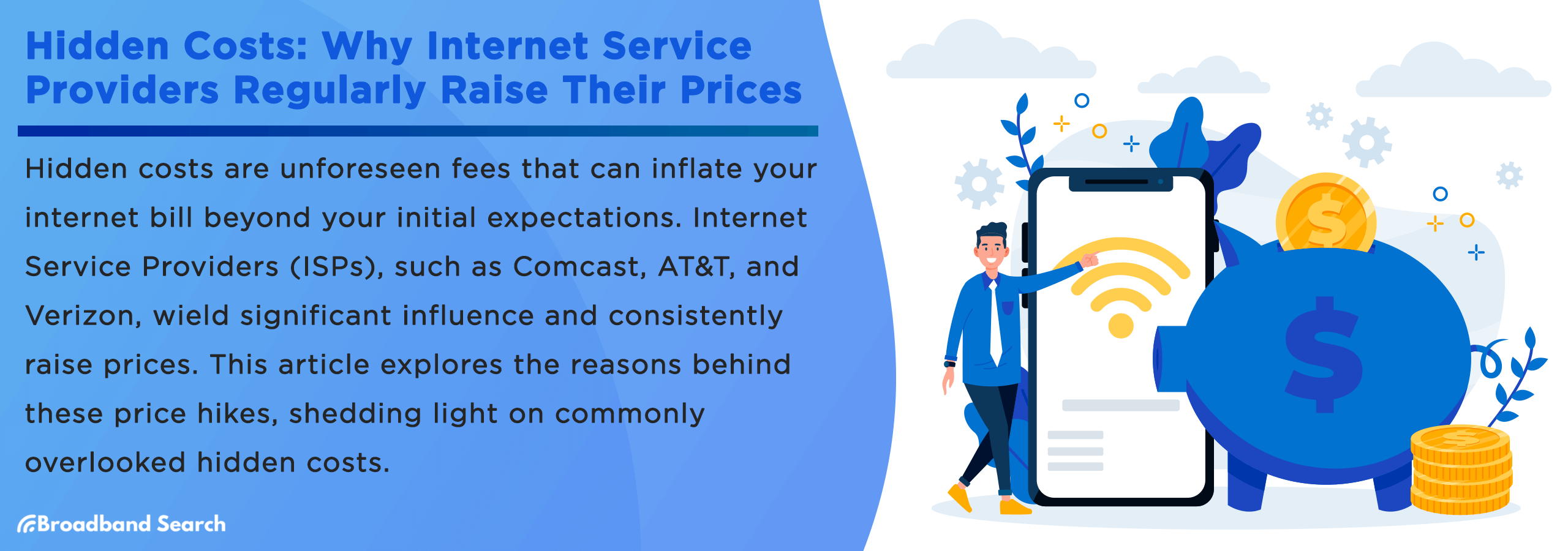Hidden costs are like surprise charges you didn't see coming when you signed up for something. When it comes to your internet bill, hidden costs can make it more expensive than you thought. Things like fees for equipment limits on how much data you can use, and penalties for canceling early can add up quickly.
Internet Service Providers (ISPs) are the companies that give you access to the internet, and some of them are pretty big, like Comcast, AT&T, and Verizon. These companies have a lot of power, and they keep raising their prices. In this article, we'll figure out why they do that, with a focus on the hidden costs that most people overlook.
Historical Context
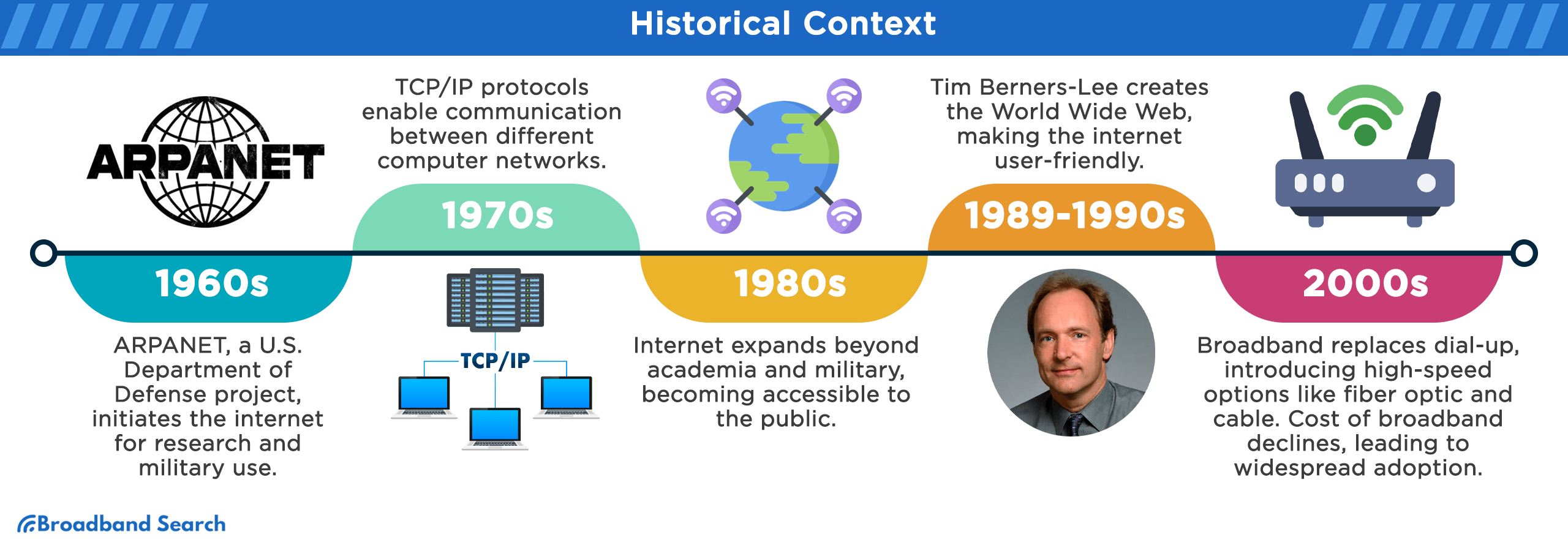
Brief History of the Internet and Its Evolution
The internet we use today didn't happen overnight. It's gone through some major stages of development. Here are some key milestones:
- 1960s - The Birth: The internet began as ARPANET, a U.S. Department of Defense project. It was designed to connect computers for research and military purposes.
- 1970s - TCP/IP Protocols: The development of TCP/IP protocols made it possible for different computer networks to communicate with each other, laying the foundation for the modern internet.
- 1980s - Widespread Adoption: The internet expanded beyond academia and the military, becoming more accessible to the public.
- 1989 - 1990s - The World Wide Web: The creation of the World Wide Web by Tim Berners-Lee made the internet user-friendly, introducing concepts like web browsers and websites.
- 2000s - Broadband and Mobile Internet: In the 2000s, the internet landscape saw significant changes. High-speed broadband internet emerged, replacing slower dial-up connections and making various connection types like fiber optic and cable accessible to homes. Fiber optic connections began rolling out, setting new standards for internet performance. Cable internet also gained popularity as a high-speed option.
By the mid-2000s, the cost of broadband, characterized by its fast and always-on nature, had started to decline. This prompted more people to switch from dial-up to broadband for its improved speed and reliability.
Emergence of ISPs and Their Early Pricing Models
In the early days of the Internet, ISPs had different ways of charging for their services:
- Hourly Rates: In the early days of the Internet, some Internet Service Providers (ISPs) used an hourly payment system. It was a bit like how you pay for your phone calls. AOL (America Online), one of the first ISPs, used this hourly pricing model for its dial-up services. Users were charged based on the number of hours they spent online. For instance, AOL charged its users $2.95 per hour when they exceeded their allotted time on either the $9.95-for-five-hours or the $19.95-for-20-hours plans. This hourly fee continued until December 1996 when AOL switched to a flat monthly rate of $19.95 for unlimited internet access.
- Flat Monthly Fees: As more people started using the internet, ISPs began offering monthly plans. You paid a fixed amount every month, and you could use the internet as much as you wanted without worrying about the time.
- Tiered Plans: ISPs also offered different types of plans. If you wanted faster internet, you could pay a bit more. It was like choosing different speeds for your internet, depending on what you needed.
Initial Promises of Affordable Internet Access
When the Internet first became available to the public, it came with promises of being affordable and accessible for everyone. People believed that the Internet would be a tool within everyone's financial reach, making it a cost-effective means for education, communication, and access to information.
Back in 2004, President Bush even talked about making affordable high-speed Internet available to all Americans by 2007, emphasizing its importance for the country's economy. However, at the time, there were no specific plans mentioned on how this goal would be achieved
Moreover, the internet was seen as a great equalizer, ensuring that all individuals, regardless of their background or location, would have the same access to information and opportunities, promoting fairness and inclusivity.
The Current Landscape
Snapshot of the Current ISP Market
In the present day, the Internet Service Provider (ISP) market is a complex landscape with a few key players holding significant market share. Prominent ISPs like Comcast, AT&T, and Verizon dominate the market, collectively serving millions of customers across the United States. These major ISPs have extensive networks and offer various services, including broadband internet, cable television, and telephone services. Their widespread coverage and established infrastructure make them the go-to choice for many consumers.
Most Popular Internet Service Provider in the U.S.
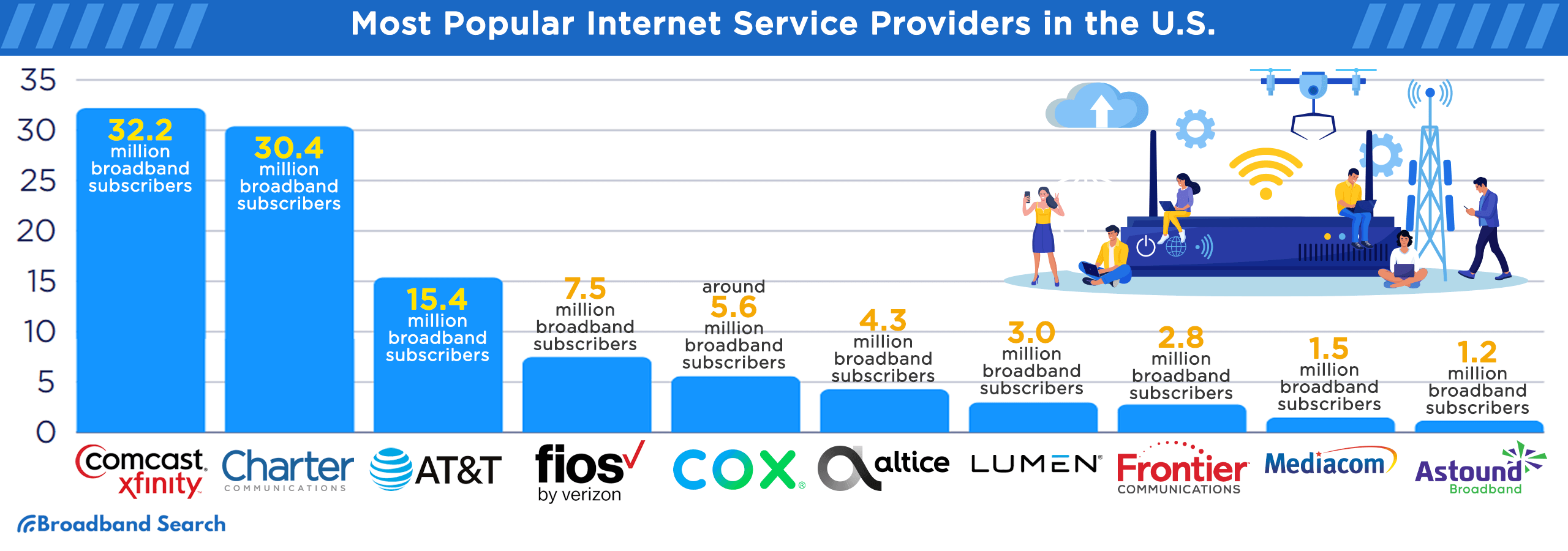
The following list ranks the 10 most popular ISPs in the U.S. based on their subscriber numbers:
- Comcast (Xfinity): With 32.2 million broadband subscribers, Comcast is a major cable and internet provider.
- Charter Communications (Spectrum): Charter serves 30.4 million broadband subscribers and offers cable and internet services.
- AT&T (AT&T Fiber): AT&T, known for its fiber optic broadband service, has 15.4 million broadband subscribers.
- Verizon (Verizon Fios): Verizon provides internet services under the Verizon Fios brand and serves 7.5 million wireline broadband subscribers.
- Cox Communications (Cox Internet): Cox has approximately 5.6 million broadband subscribers and offers cable and internet services.
- Altice USA (Optimum and Suddenlink): Altice USA, operating under the Optimum and Suddenlink brands, serves 4.3 million broadband subscribers.
- Lumen Technologies (Quantum Fiber and CenturyLink): Lumen Technologies has 3.0 million broadband subscribers and offers telecommunications and internet services.
- Frontier Communications (Frontier): With 2.8 million broadband subscribers, Frontier Communications provides telecommunications and internet services.
- Mediacom Communications (Xtream): Mediacom, offering services through the Xtream brand, serves approximately 1.5 million broadband subscribers.
- Astound Broadband: Astound Broadband boasts over 1.2 million broadband subscribers.
Rising Consumer Dissatisfaction with Pricing
Many consumers are becoming increasingly dissatisfied with the cost of their internet service. Recent studies and surveys have highlighted these concerns. The American Customer Satisfaction Index (ACSI) revealed that customer satisfaction in the Internet Service Provider (ISP) industry stands at a mere 68 points, nearly the lowest score among all surveyed industries. Only the gas station industry scored lower, indicating that a significant number of customers are unhappy with their internet bills.
In 2022, ISPs ranked 45th in customer satisfaction, receiving a rating of 64 on a scale of zero to 100. This score placed ISPs just two points ahead of subscription TV services, indicating a significant level of dissatisfaction with internet bills. Notably, the industry's satisfaction rating dropped by 1.5 percent from the previous year.
Customers often express frustration over the following pricing-related issues:
- High Monthly Bills: Many consumers find their monthly internet bills to be relatively high, especially when compared to the quality and speed of the service they receive.
- Hidden Fees: Hidden charges, such as equipment rental fees and unexpected surcharges, contribute to the perception that ISPs are not transparent about their pricing.
- Limited Choice: In some areas, consumers have limited options for ISPs, which can result in monopolistic or oligopolistic market conditions, leading to less competitive pricing.
- Price Hikes: Customers often report experiencing frequent price increases for their internet services, sometimes without significant improvements in speed or quality.
- Promotional Pricing: Some consumers feel misled by promotional offers that provide low introductory rates but later increase substantially.
Identifying Hidden Costs
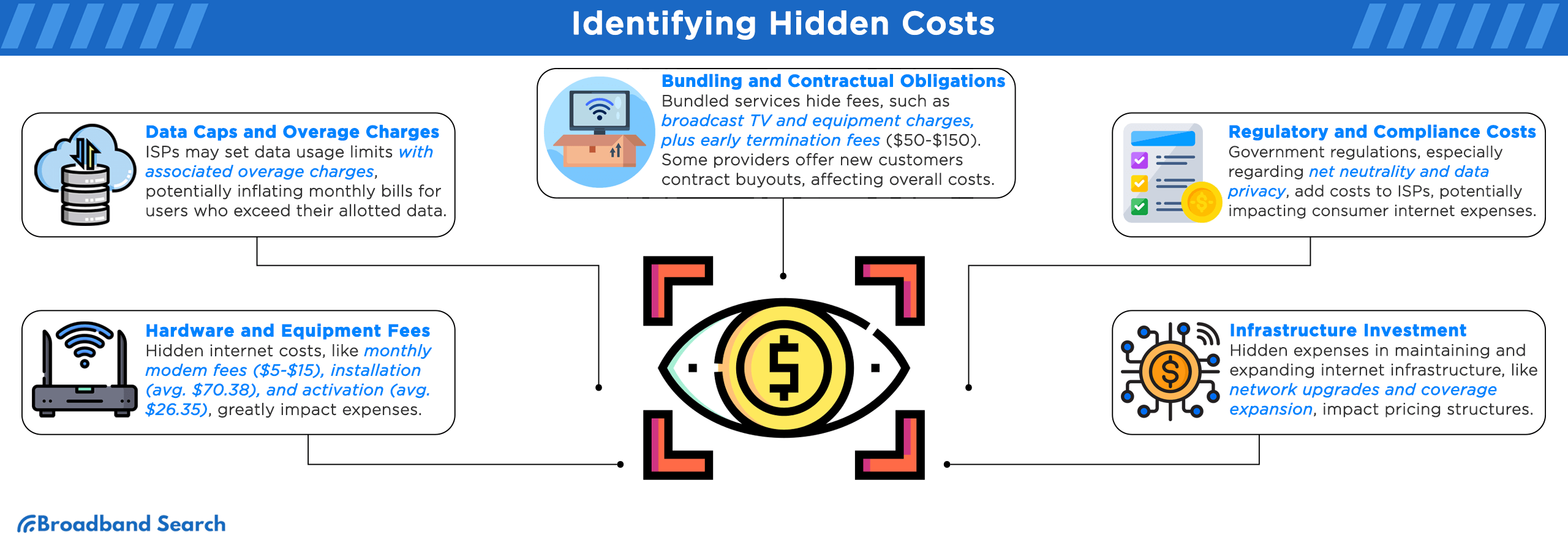
Hardware and Equipment Fees
When it comes to hidden costs, hardware and equipment fees are a common culprit. Here's a detailed breakdown:
Modem and Router Rental Charges: ISPs often charge a monthly fee for renting the modem and router needed to connect to the internet. These charges can range from $5 to $15 per month, which can add up significantly over time.
Installation and Activation Fees: Installation and activation fees are common costs when getting internet service. On average, installation fees in the New America Org dataset are about $53.74, while activation fees are around $27.79. Across the United States, people typically pay an average installation fee of $70.38 and an activation fee of $26.35 for their internet service setup.
Data Caps and Overage Charges
- Data Usage Limits: ISPs may impose limits on the amount of data you can use each month. These limits vary between plans and can result in additional charges if you exceed them.
- Overage Charges: When you surpass your data limit, ISPs may levy overage charges. These fees can significantly inflate your monthly bill if you regularly exceed your allotted data.
Bundling and Contractual Obligations
Hidden Fees in Bundled Services: ISPs often bundle the internet with other services like cable TV or home phones. While these bundles may seem cost-effective, they can contain hidden fees that become apparent only after you've signed up. Hidden fees in bundled services, such as cable TV or home phone, can include broadcast TV fees, regional sports fees, equipment rental fees, installation fees, service activation fees, early termination fees, and various taxes and surcharges. These fees might not be immediately apparent when you sign up for bundled services but can significantly impact your overall cost.
Early Termination Fees:Early Termination Fees can be a concern if you decide to cancel your ISP contract before its agreed-upon end date. These fees are like penalties for ending the contract early and can be quite hefty, typically ranging from $50 to $150. Switching providers can be costly due to these fees.
However, some internet providers offer to cover these early termination fees for you. They may do this through bill credits or by sending you a check for the fee amount, usually up to $500. Providers like Optimum, Spectrum, and Verizon Fios are known to extend contract buyout offers to new customers, which can help ease the transition.
Regulatory and Compliance Costs
Due to government rules, ISPs have to deal with regulatory and compliance costs. These costs can increase how much it takes to run their services. For instance, following net neutrality and data privacy laws can be expensive for them. These extra costs, even though they're not always obvious, can affect how much you pay for your internet service.
Infrastructure Investment
Maintaining and expanding the internet infrastructure also incurs hidden expenses:
Constant Network Upgrades: To keep up with increasing demands for faster and more reliable internet, ISPs must invest in regular upgrades to their network infrastructure. These costs are not always visible to customers but can influence pricing.
Coverage Area Expansion: Expanding the coverage area to reach underserved or remote locations requires significant investments in infrastructure. While essential for connecting more people, these costs can impact the overall pricing structure.
Business Strategies Behind Price Increases
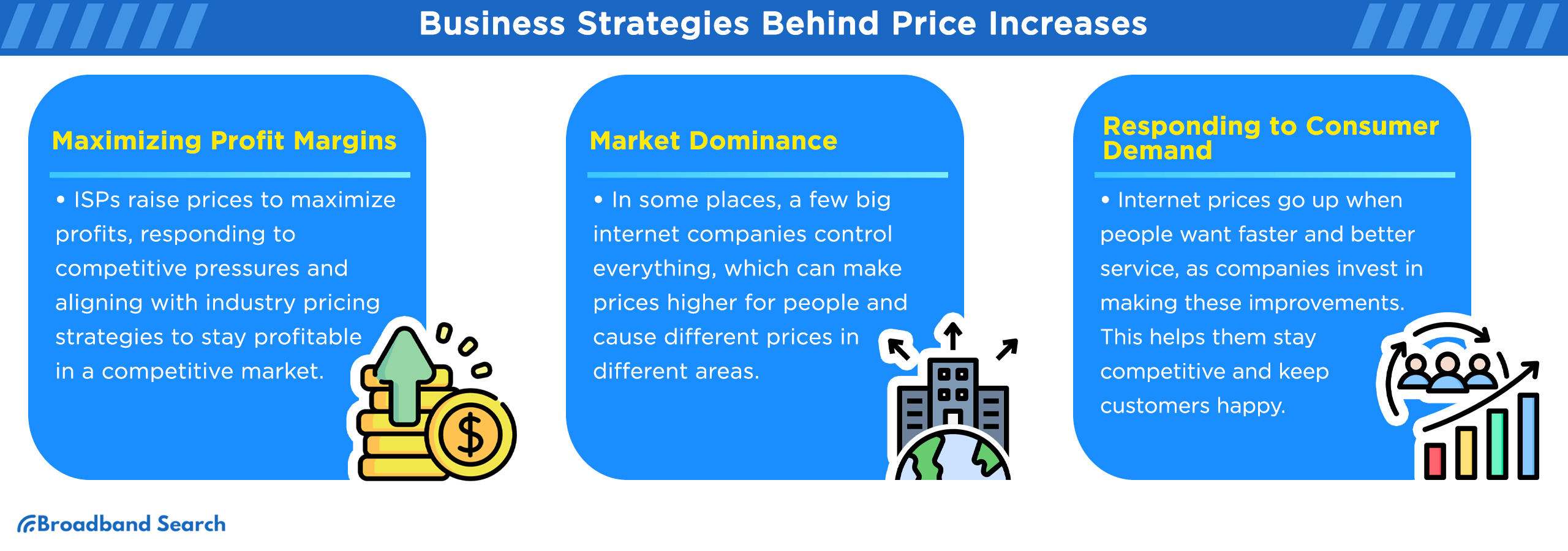
Maximizing Profit Margins
ISPs have a clear business strategy when it comes to raising their prices – they want to make more money. Just like any other company, ISPs aim to increase their profits and boost the value of their shares. One way to achieve this is by raising the prices they charge their customers. Additionally, competitive pressures play a significant role in pricing decisions. In a highly competitive market, ISPs may need to adjust their prices to stay profitable. This often means following the pricing strategies of their competitors, which can result in price hikes for consumers.
Market Dominance
The level of competition in the ISP market varies from one region to another. In some areas, there is limited competition, and this can lead to market dominance by a few key ISPs. When ISPs dominate a market, they have more control over pricing. This control can result in higher costs for consumers, as there are fewer alternatives to choose from.
Additionally, price discrimination can come into play, where ISPs charge different prices for similar services in different regions. This can create disparities in what customers pay based on their geographical location.
Responding to Consumer Demand
The evolving landscape of consumer demand shapes ISP pricing strategies. ISPs adjust their prices to meet changing consumer expectations, and this includes addressing:
- Rising Bandwidth Needs: As consumers increasingly rely on streaming, online gaming, and other bandwidth-intensive activities, they expect faster and more reliable internet connections. ISPs invest in upgrading their infrastructure and technology to provide these higher speeds, which can lead to price adjustments.
- Adapting to Provide Faster Speeds and Improved Services: ISPs respond to consumer demands by offering faster internet plans and improved services. These enhancements often come with higher price tags, covering the costs associated with infrastructure upgrades and technology investments. ISPs adapt to meet these demands, recognizing that providing better services and faster speeds is crucial to remaining competitive in the market and retaining satisfied customers.
The Role of Government Regulation
Overview of Regulatory Bodies
Regulatory bodies, like the Federal Communications Commission (FCC) in the United States, play a critical role in overseeing the telecommunications and internet industry. They are responsible for setting rules and standards governing ISPs and other telecommunications companies' operations. This includes regulating pricing, ensuring fair competition, and safeguarding consumer interests. Regulatory agencies like the FCC can enforce these rules, impose fines, and make decisions that impact the entire industry.
The Impact of Deregulation on Pricing
When there's less government oversight, like in the case of deregulation, it can affect how much ISPs charge for their services. Deregulation means there are fewer rules that ISPs have to follow, giving them more freedom in how they set prices.
Some people say this can lead to more competition and lower prices. But others worry that it can also mean less fairness, possible price increases, and not-so-great practices by ISPs. In deregulated markets, ISPs might focus more on making money, and that could affect how affordable internet services are for regular folks.
The Debate Over Net Neutrality and its Implications
The net neutrality debate is a big deal because it can impact how much you pay for the internet and what you can do with it. Net neutrality essentially means that ISPs should treat all internet traffic the same way, without playing favorites or throttling certain websites or services.
If there are no net neutrality rules, ISPs might start charging more for better access to certain websites or online services (either to you or to service providers). That could make the internet more expensive, especially if you have to pay extra to get to the websites you love.
The Bottom Line
We've delved into various facets of internet service provider (ISP) pricing. Hidden costs can sneak into your internet bill, making it more expensive than it seems. ISPs adjust their prices for reasons such as profit maximization, competition, and the need to meet growing demands for faster internet. The role of government regulations is especially noteworthy, impacting ISP pricing in diverse ways.
As consumers, advocating for transparent and fair pricing is crucial. By staying informed about your ISP's pricing, exploring alternatives, and engaging in the discussion, you can make informed choices about your internet service.
FAQ
How can I avoid falling victim to hidden costs in my internet bill?
To avoid hidden costs, carefully read your ISP's terms and conditions, ask about all fees during sign-up, and regularly review your bill for unexpected charges.
How can I stay informed about potential regulatory changes affecting ISP pricing?
To stay informed, follow technology news, participate in consumer advocacy groups, and monitor announcements from government regulatory agencies like the FCC (in the United States).
Are early termination fees common with ISPs?
Yes, early termination fees are common in ISP contracts. There are penalties for canceling your service before the agreed-upon contract end date.
How does net neutrality affect ISP pricing?
Net neutrality ensures that ISPs treat all internet traffic equally. Without net neutrality, ISPs might create tiered pricing models, potentially charging more for access to specific websites or services.
What steps can I take to ensure I have a clear understanding of my ISP's pricing?
Read your ISP's contract thoroughly, ask for explanations of any unclear terms, and keep records of your billing statements to track any changes or hidden costs.

